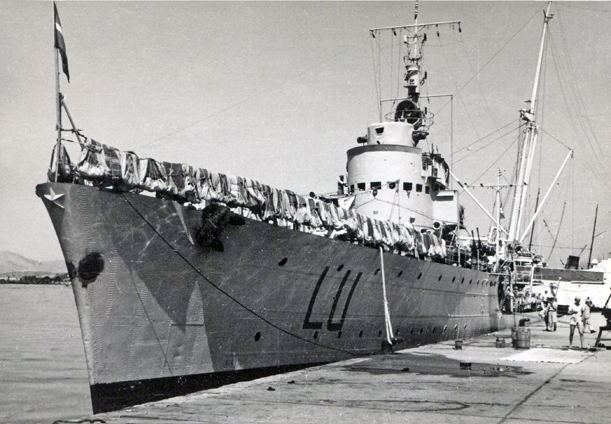1 tanker disabled none | ||
 | ||
The Attack on Convoy AN 14 was a naval engagement during World War II between a British naval force defending a convoy of merchant ships, which had departed from Port Said and Alexandria to Piraeus and two Italian torpedo boats who intercepted them north of Crete on 31 January 1941. The Italian vessels, Lupo and Libra, launched two torpedoes each. The torpedoes fired by Libra missed their target but one from Lupo hit and disabled for the rest of the war the 8,120 long tons (8,250 t) British tanker Desmoulea which had to be towed to Suda Bay in Crete and beached. One other merchant ship turned back; the other eight vessels reached Piraeus.
Contents
Background
When hostilities commenced between Fascist Italy and Greece, the British began to send supplies of aircraft and stores through the Aegean Sea, to support the Greek war effort. The Greek government provided the Allies with tugs, harbour vessels and a naval base for the British Fleet at Suda Bay in Crete. Greece and Britain concluded a co-operation agreement in January 1940, which secured commercial relations and made the Greek merchant fleet available for the transport of war supplies to the Allies, before the Greco-Italian War began in October 1940.
Allied forces
Convoy AN 14 consisted of seven British and three Greek merchant ships, escorted by the light cruiser HMS Calcutta (Commander Herbert Annesley Packer), the destroyers HMS Dainty and Jaguar and the corvettes HMS Peony and Gloxina. The bulk of the convoy sailed from Port Said on 28 January, with the corvette Gloxina. Levernbank and the large tanker Desmoulea, escorted by Calcutta and Peony, departed Alexandria on 29 January. The troop transport Ethiopia, carrying RAF personnel, left Alexandria some hours later, with the destroyer HMS Hasty. The cruiser HMS Ajax and the Australian light cruiser HMAS Perth were to provide distant cover; Jaguar and Dainty swept the Kaso strait ahead of the convoy.
Italian forces
Italian naval forces in the Dodecanese had limited capacity to supply garrisons, since the beginning of the war with Britain in June 1940. Most supplies were carried by submarine and aircraft but the expedient was insufficient and the Italians began to use coastal ships. The ships ferried 4,500 long tons (4,600 t) of supplies to the Dodecanese, even after the closing of the Corinth Channel, after the beginning of the Greco-Italian War. A flotilla of torpedo boats were deployed in the area by the Regia Marina in December 1940, under the command of captain Francesco Mimbelli, to reinforce the ships around Rhodes and Leros, whose naval base of Porto Lago (Lakki) was the main Italian naval base in the Aegean.
Action
On 31 January 1941, the Italian torpedo boats departed Leros and performed an anti-submarine search in the Kaso Strait, when they spotted an Allied convoy escorted by a cruiser and three destroyers. The two vessels separated, for Libra to distract the escort while Lupo attacked with its 450 mm (18 in) torpedoes. The Italians reported that Lupo hit a large steamer with two torpedoes and then Libra launched another two at a cruiser without effect. The Italians were engaged by the escorts but managed to steam away.
In the British account, only one torpedo hit the tanker Desmoulea, which was loaded with a cargo of petrol and white oils. Admiral Andrew Cunningham recorded that the tanker had been detached to Suda Bay from the Alexandria section of the convoy and was torpedoed at 18:00 on 31 January. Dainty, the close escort, took the tanker in tow at 20:00, after it been abandoned by the crew. Perth proceeded to assist but the Commander in Chief ordered Perth to resume escort duties. Desmoulea had been hit abreast the engine room and left sinking, but the crew re-boarded the tanker when it became clear that it was still afloat. Desmoulea arrived in Suda Bay under tow at 08:00 on 1 February and beached with its cargo intact. Peony survived an attack by bombers 40 nmi (46 mi; 74 km) from Crete and the rest of the convoy reached Piraeus on 2 February 1941.
Aftermath
Desmoulea remained at Suda Bay for several weeks, down on the sandy bottom by the stern, with its after well deck awash; the cargo was transferred to the tanker Eocene. Along with the torpedo attack on the cargo ship Clan Cumming by the Italian submarine Neghelli on 19 January, this was the only Italian success against British convoys in the Aegean Sea. After the action, Allied shipping made passage into the Aegean through the Antikithera Strait. Desmoulea was finally taken in tow by the armed boarding vessel HMS Chakla and escorted to Port Said by the anti-submarine trawlers HMS Lydiard and HMS Amber. The ship arrived on 6 May and moored off the western beacon of Suez, for use as a temporary storage vessel. It was torpedoed again on 3 August 1941, while awaiting repairs, by German bombers. Desmoulea was towed to Bombay, India and ran aground twice during the passage. Desmoulea was converted into a store ship, named Empire Thane and remained in port at Cochin until 1947, from where it was towed back to the United Kingdom. It was rebuilt under its original name in 1949, before being laid up in 1955 and scrapped in 1961.
